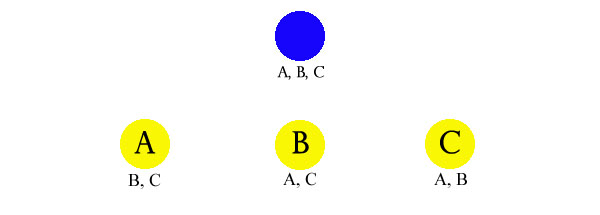UPDATE: This page is out of date and no longer maintained. I’m leaving it up to keep the comments archived, but for a complete index of all articles related to node-based scenario design, check Part 1 of the series.
Here’s a convenient index of Node-Based Scenario Design for easy access, easy reading, and easy linking.
Part 1: The Plotted Approach
Part 2: Choose Your Own Adventure
Part 3: Inverting the Three Clue Rule
Part 4: Sample Scenario – Las Vegas CTU
Part 5: Plot vs. Node
Part 6: Alternative Node Design
Part 7: More Alternative Node Designs
Part 8: Freeform Design in the Cloud
Part 9: Types of Nodes
The essays on the Three Clue Rule and scenario-based design make for good supplementary reading if you haven’t seen them already.
UPDATE: A a sequel or supplement for Node-Based Scenario Design has been written under the mind-numbingly clever title Advanced Node-Based Design.














ARCHIVED HALOSCAN COMMENTS
Echo 1 Items
Kaprou
Thank you.
Monday, June 28, 2010, 10:13:38 AM
The url to Advanced Design Pt1 isn’t working. The correct one is:
http://thealexandrian.net/wordpress/8171/roleplaying-games/advanced-node-based-design-part-1-moving-between-nodes
Not sure if you get updates about comments here or if you’ll ever see this, but I want to say thanks for this series. I’ve read it probably 20 times in the last year, and every time it gives me new ideas and helps me structure my campaign as a first time gm (well, not counting one offs). I’ve searched the internet for practical GM tips, and this is by far the most unique and useful series I’ve found.
One thing that I still struggle with in this series is session pacing. Breaking things down into nodes is great, but I have trouble knowing how many nodes my players will get through in a particular play session. In your examples would you consider each node it’s own session?
I’d love to be able set it up so that they can get through some sort of story arc each session and make the experience more episodic instead of frequently dangling in the middle of a mystery and having players forget important clues in the mean time (good thing they have 3, but still)
I realize a lot of this has to do with experience, but I feel like there has to be an article in there somewhere.
I’ve always been absolutely terrible at estimating the amount of time it will take for players to complete a given piece of content. Recently, though, I’ve come to the conclusion that this has more to do with the the players than with the content.
For example, I’ve been running the Ego Hunter one-shot for Eclipse Phase for several groups. One group finished the adventure in a single session; one group just finished its sixth session (and still hasn’t completed the adventure); and another group will probably be wrapping it up in their second session next week.
Different approaches to the material, different table etiquette, and different luck all play a big role in determining time spent.
But in more general terms: No, I generally wouldn’t create a “1 node = 1 session” approach. For example, I’d probably expect the CTU Las Vegas example to only take up a single session.
OTOH, in my Ptolus campaign each “node” is really a full adventure in itself. Some of those are short adventures that would only take up a single session. Others are sprawling dungeon complexes with hundreds of rooms.
To put it another way: I tend to structure nodes in terms of useful conceptual grouping rather than playing time. Often, this means I’m looking at “this is the chunk of information that these clues point to” or “this is the chunk of the investigation that contains these three clues”.
For example, I’m currently working on developing a new node in my Ptolus campaign based on an unexpected direction the PCs have decided to loop. The “node” is defined as “the Vladaam criminal network”, because that’s conceptually useful for me in terms of orienting the material within the context of the larger campaign. This particular node, however, is large enough and complex enough that I’ve broken it into several groupings of sub-nodes: For example, there are the Alchemical Labs (4 nodes) and the Curse Dens (3 nodes) in addition to other, singular nodes.
So other sections of the campaign might contain clues which point to “node BW04B House Vladaam”, because that’s a useful tag that lets me flip to the notes for House Vladaam. And then inside BW04B, I’ve got a whole bunch of other nodes that I’ve liberally seeded using the inverted Three Clue rule so that players investigating the Vladaam criminal network will be able to work their way through it.
A metaphor I find useful for myself is that of a “tributary”: Big meta-relationships between conceptual groupings form the overall “flow” of the campaign. And then each of those groupings (i.e. nodes) can function relatively independently as node-based adventures, location-based adventures, hexcrawls, skill challenges, or whatever else seems appropriate for the moment.
Not sure if anything in that ramble was useful to you. But there it is. 😉
[…] He elegido empezar por un sistema “Basado en nodos”, cortesía del blog “The Alexandrian”. El enlace, aquí. […]
[…] I just stating the obvious? Credit where it’s due, there’s a lot more detail on this here, on The […]